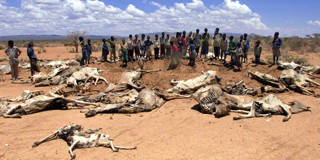After years of steady decline, the pace of global hunger is creeping up, and parts of Africa today are in the midst of the worst food crisis since World War II. Averting future famines on the continent is possible, but only if regional and global donors make the development of smallholder farming a high priority.
NEW YORK – After falling for more than a decade, the number of hungry people in the world is rising once again. This year was marked by the worst global food crisis since World War II, with South Sudan, Yemen, Somalia, and Nigeria either experiencing famine or teetering on the brink. More than 20 million people in those four countries alone remain severely food-insecure, and the United Nations estimates that $1.8 billion in immediate humanitarian aid is needed.
Political instability and conflict have contributed heavily to this food insecurity, but insufficient food production has also likely heightened tensions and exacerbated hunger. In Sub-Saharan Africa, where three of the four countries on the verge of famine are located, crop yields have long lagged behind the rest of the world, owing to poor farm inputs, such as low-quality seeds and fertilizer.
Investing in agriculture is one of the most effective ways to end hunger and improve political stability. There are 50 million smallholder farmers in Sub-Saharan Africa alone, and they support many millions more. Countries on the continent that have invested heavily in agricultural development and smallholder farmers have been successful at avoiding famine.

NEW YORK – After falling for more than a decade, the number of hungry people in the world is rising once again. This year was marked by the worst global food crisis since World War II, with South Sudan, Yemen, Somalia, and Nigeria either experiencing famine or teetering on the brink. More than 20 million people in those four countries alone remain severely food-insecure, and the United Nations estimates that $1.8 billion in immediate humanitarian aid is needed.
Political instability and conflict have contributed heavily to this food insecurity, but insufficient food production has also likely heightened tensions and exacerbated hunger. In Sub-Saharan Africa, where three of the four countries on the verge of famine are located, crop yields have long lagged behind the rest of the world, owing to poor farm inputs, such as low-quality seeds and fertilizer.
Investing in agriculture is one of the most effective ways to end hunger and improve political stability. There are 50 million smallholder farmers in Sub-Saharan Africa alone, and they support many millions more. Countries on the continent that have invested heavily in agricultural development and smallholder farmers have been successful at avoiding famine.